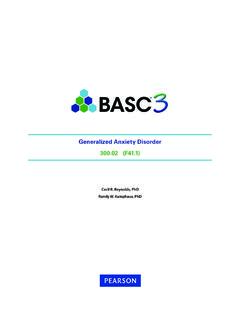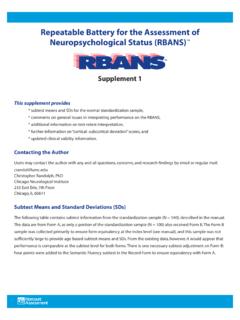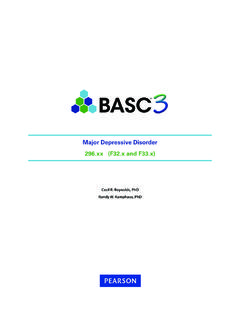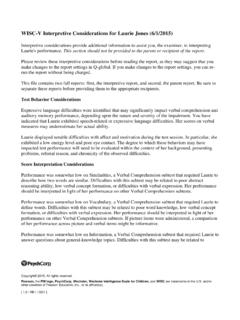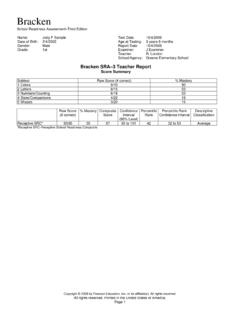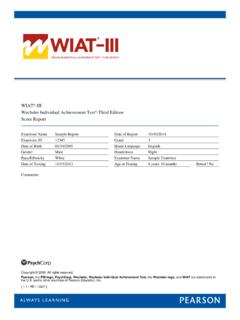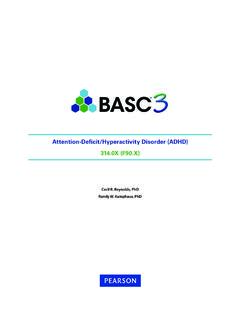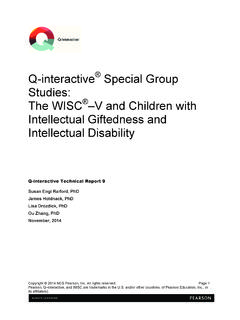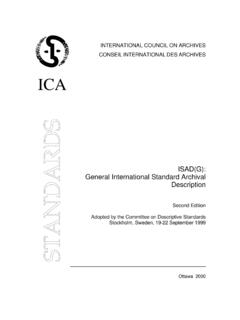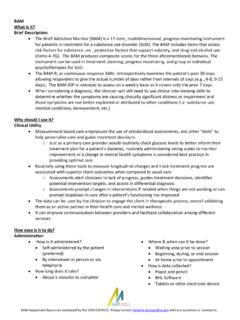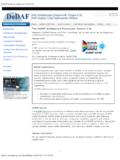Transcription of MMPI-2-RF Psychiatric Inpatient Interpretive Report Sample
1 Sample REPORTCase descriptions do not accompany MMPI-2-RF reports, but are provided here as background information. The following Report was generated from Q-global , Pearson s web-based scoring and reporting application, using Mr. I. s responses to the MMPI-2-RF . Additional MMPI-2-RF Sample reports, product offerings, training opportunities, and resources can be found at 2014 Pearson Education, Inc. or its affiliate(s). All rights reserved. Q-global, Always Learning, Pearson, design for Psi, and PsychCorp are atrademarks, in the and/or other countries, of Pearson Education, Inc. or its affiliate(s). Minnesota Multiphasic Personality Inventory-2 Restructured Form and MMPI-2-RF are registered trademarks of the University of Minnesota, Minneapolis, MN. 8795-A 01/14 Case Description: Mr. I Psychiatric Inpatient Interpretive ReportMr. I is a 46-year-old, married man admitted for Inpatient treatment after presenting with psychotic thinking and assaultive behavior.
2 At intake, he described a recent pattern of decreased sleep and presented with bizarre delusional thinking, religious preoccupation, visual hallucinations, and tangential and circumstantial thinking. He had previously been diagnosed with Schizophrenia and Schizoaffective Disorder. Interpretive Report : Clinical SettingsMMPI-2-RF Minnesota Multiphasic Personality Inventory-2-Restructured Form Yossef S. Ben-Porath, PhD, & Auke Tellegen, PhDID Number: Mr. I Age: 36 Gender: Male Marital Status: Married Years of Education: Not reported Date Assessed:1/13/14 Copyright 2008, 2011, 2012 by the Regents of the University of Minnesota. All rights exclusively under license from the University of Minnesota by NCS Pearson, Inc. Portions reproduced from the MMPI-2-RF testbooklet. Copyright 2008 by the Regents of the University of Minnesota. All rights reserved.
3 Portions excerpted from the MMPI-2-RF Manualfor Administration, Scoring, and Interpretation. Copyright 2008, 2011 by the Regents of the University of Minnesota. All rights by permission of the University of Minnesota , the MMPI-2-RF logo, and Minnesota Multiphasic Personality Inventory-2-Restructured Form are registered trademarks ofthe University of Minnesota. Pearson, the PSI logo, and PsychCorp are trademarks in the and/or other countries of Pearson Education,Inc., or its affiliate(s).TRADE SECRET INFORMATIONNot for release under HIPAA or other data disclosure laws that exempt trade secrets from disclosure.[ / 1 / QG ]SAMPLEMMPI-2-RF Validity Scales2010090807060504030K-rL-rFBS-rFsFp -rF-rTRIN-rVRIN-rRaw Score:Response %:VRIN-rTRIN-rF-rFp-rVariable Response InconsistencyTrue Response InconsistencyInfrequent ResponsesInfrequent Psychopathology Responses34894 FsFBS-rRBSI nfrequent Somatic ResponsesSymptom ValidityResponse Bias Scale36694042957749712571002322471004461 00120110 Cannot Say (Raw):17T Score:T52 Percent True (of items answered):%636076TT535262536310191528101 41218 TComparison Group Data: Psychiatric Inpatient , Community Hospital (Men), N = 659------------------------------------- --------------Standard DevMean Score1 SD+( ):( ):_8745732558764522 Percent scoring at orbelow test taker:L-rK-rUncommon VirtuesAdjustment highest and lowest T scores possible on each scale are indicated by a "---"; MMPI-2-RF T scores are non-gendered.
4 ID: Mr. IMMPI-2-RF Interpretive Report : Clinical Settings 1/13/14, Page 2 SAMPLEMMPI-2-RF Higher-Order (H-O) and Restructured Clinical (RC) Scales2010090807060504030RC9RC8RC7RC6RC4 RC3RC2RC1 RCdBXDTHDEIDRaw Score:T Score:Response %:EIDTHDBXDE motional/Internalizing DysfunctionThought DysfunctionBehavioral/Externalizing Dysfunction543100 RCdRC1RC2RC3RC4 DemoralizationSomatic ComplaintsLow Positive EmotionsCynicismAntisocial BehaviorRC6RC7RC8RC9 Ideas of PersecutionDysfunctional Negative EmotionsAberrant ExperiencesHypomanic Activation142933491001368964609603410096 2100547470946669495596248096120110 Higher-OrderRestructured Clinical63586460596364526358565216141512 1717131217151412------------------------ ---------------------------------------- --------47 Comparison Group Data: Psychiatric Inpatient , Community Hospital (Men), N = 659 Standard DevMean Score1 SD+( ):( ).
5 _Percent scoring at orbelow test taker:14192275663484475765599 The highest and lowest T scores possible on each scale are indicated by a "---"; MMPI-2-RF T scores are non-gendered. ID: Mr. IMMPI-2-RF Interpretive Report : Clinical Settings 1/13/14, Page 3 SAMPLEMMPI-2-RF Somatic/Cognitive and Internalizing Scales2010090807060504030 NFCANPAXYSTWMSFBRFNUCGICHPCHLPCOGSFDRaw Score:T Score:Response %:MLSGICHPCNUCCOGM alaiseGastrointestinal ComplaintsHead Pain ComplaintsNeurological ComplaintsCognitive Complaints252100 AXYANPBRFMSFA nxietyAnger PronenessBehavior-Restricting FearsMultiple Specific FearsSUIHLPSFDNFCSTWS uicidal/Death IdeationHelplessness/HopelessnessSelf-Do ubtInefficacyStress/Worry569100153900421 0004610021000421001521003511000441002471 00354100246100043100 Somatic/CognitiveInternalizing1201106260 6054587460585761585347531416141215251316 13171312912 Comparison Group Data: Psychiatric Inpatient , Community Hospital (Men), N = 659------------------------------------- ---------------------------------------- -------MLS79 SUI3473443753642551443731675551 Standard DevMean Score1 SD+( ):( ):_Percent scoring at orbelow test taker:The highest and lowest T scores possible on each scale are indicated by a "---"; MMPI-2-RF T scores are non-gendered.
6 ID: Mr. IMMPI-2-RF Interpretive Report : Clinical Settings 1/13/14, Page 4 SAMPLEMMPI-2-RF Externalizing, Interpersonal, and Interest Scales2010090807060504030 SAVMECAESACTAGGSUBJCPFMLDSFIPPSHYRaw Score:T Score:Response %:FMLIPPSAVSHYDSFF amily ProblemsInterpersonal PassivitySocial AvoidanceShynessDisaffiliativeness150100 JCPSUBAGGACTJ uvenile Conduct ProblemsSubstance AbuseAggressionActivationAESMECA esthetic-Literary InterestsMechanical-Physical Group Data: Psychiatric Inpatient , Community Hospital (Men), N = 659 Standard DevMean Score1 SD+( ):( ):_Percent scoring at orbelow test taker:The highest and lowest T scores possible on each scale are indicated by a "---"; MMPI-2-RF T scores are non-gendered. ID: Mr. IMMPI-2-RF Interpretive Report : Clinical Settings 1/13/14, Page 5 SAMPLEMMPI-2-RF PSY-5 Scales2010090807060504030 INTR-rNEGE-rDISC-rPSYC-rAGGR-rRaw Score:T Score:Response %:AGGR-rPSYC-rDISC-rNEGE-rINTR-rAggressi veness-RevisedPsychoticism-RevisedDiscon straint-RevisedNegative Emotionality/Neuroticism-RevisedIntrover sion/Low Positive Emotionality-Revised15741000321006499011 63955639612011050585860581015141117----- -------------------------Comparison Group Data: Psychiatric Inpatient , Community Hospital (Men), N = 659 Standard DevMean Score1 SD+( ):( ):_Percent scoring at orbelow test highest and lowest T scores possible on each scale are indicated by a "---"; MMPI-2-RF T scores are non-gendered.
7 ID: Mr. IMMPI-2-RF Interpretive Report : Clinical Settings 1/13/14, Page 6 SAMPLEMMPI-2-RF T SCORES (BY DOMAIN)PROTOCOL VALIDITYSUBSTANTIVE SCALES*The test taker provided scorable responses to less than 90% of the items scored on this scale. See the relevant profile page for the specific percentage. Note. This information is provided to facilitate interpretation following the recommended structure for MMPI-2-RF interpretation in Chapter 5 of theMMPI-2-RF Manual for Administration, Scoring, and Interpretation, which provides details in the text and an outline in Table Non-Responsiveness174857 TCNSVRIN-rTRIN-rOver-Reporting74426632*4 6F-rFp-rFsFBS-rRBSU nder-Reporting4745*L-rK-rSomatic/Cogniti ve Dysfunction425246425369RC1 MLSGICHPCNUCCOGE motional Dysfunction434979524251 EIDRCdSUIHLPSFDNFC3432RC2 INTR-r55474454434649RC7 STWAXYANPBRFMSFNEGE-rThought Dysfunction6070 THDRC666RC863 PSYC-rBehavioral Dysfunction68625055 BXDRC4 JCPSUB8067677463RC9 AGGACTAGGR-rDISC-rInterpersonal Functioning4947*34364758 FMLRC3 IPPSAVSHYDSFI nterests33*74 AESMEC ID: Mr.
8 IMMPI-2-RF Interpretive Report : Clinical Settings 1/13/14, Page 7 SAMPLESYNOPSISS cores on the MMPI-2-RF validity scales raise concerns about the possible impact of unscorableresponses on the validity of this protocol. With that caution noted, scores on the substantive scalesindicate cognitive complaints and emotional, thought, behavioral, and interpersonal complaints include difficulties in memory and concentration. Emotional-internalizing findingsrelate to suicidal ideation. Dysfunctional thinking includes ideas of persecution and aberrantperceptions and thoughts. Behavioral-externalizing problems include aggression and excessiveactivation. Interpersonal difficulties relate to VALIDITYC ontent Non-Responsiveness Unscorable Responses The test taker answered less than 90% of the items on the following scales. The resulting scores maytherefore be artificially lowered.
9 In particular, the absence of elevation on these scales is notinterpretable1. A list of all items for which the test taker provided unscorable responses appears underthe heading "Item-Level Information." Symptom Validity (FBS-r): 87%Adjustment Validity (K-r): 86%Cynicism (RC3): 47%Aesthetic-Literary Interests (AES): 86%Inconsistent Responding The test taker responded to the items in a consistent manner, indicating that he responded There are no indications of over-reporting in this There are no indications of under-reporting in this Interpretive Report is intended for use by a professional qualified to interpret the information it contains should be considered in the context of the test taker's background, thecircumstances of the assessment, and other available information. ID: Mr. IMMPI-2-RF Interpretive Report : Clinical Settings 1/13/14, Page 8 SAMPLESUBSTANTIVE SCALE INTERPRETATIONC linical symptoms, personality characteristics, and behavioral tendencies of the test taker aredescribed in this section and organized according to an empirically guided framework.
10 Statementscontaining the word "reports" are based on the item content of MMPI-2-RF scales, whereas statementsthat include the word "likely" are based on empirical correlates of scale scores. Specific sources foreach statement can be viewed with the annotation features of this following interpretation needs to be considered in light of cautions noted about the possibleimpact of unscorable responses on the validity of this Dysfunction The test taker reports a diffuse pattern of cognitive difficulties2. He is likely to complain about memoryproblems3, to have low tolerance for frustration4, not to cope well with stress4, and to experiencedifficulties in Dysfunction The test taker reports a history of suicidal ideation and/or attempts6. He is likely to be preoccupied withsuicide and death7 and to be at risk for current suicidal ideation and attempts7. This risk is exacerbated bypoor impulse Dysfunction The test taker reports significant persecutory ideation such as believing that others seek to harm is likely to be suspicious of and alienated from others10, to experience interpersonal difficulties as aresult of suspiciousness11, and to lack reports unusual thought processes12.
